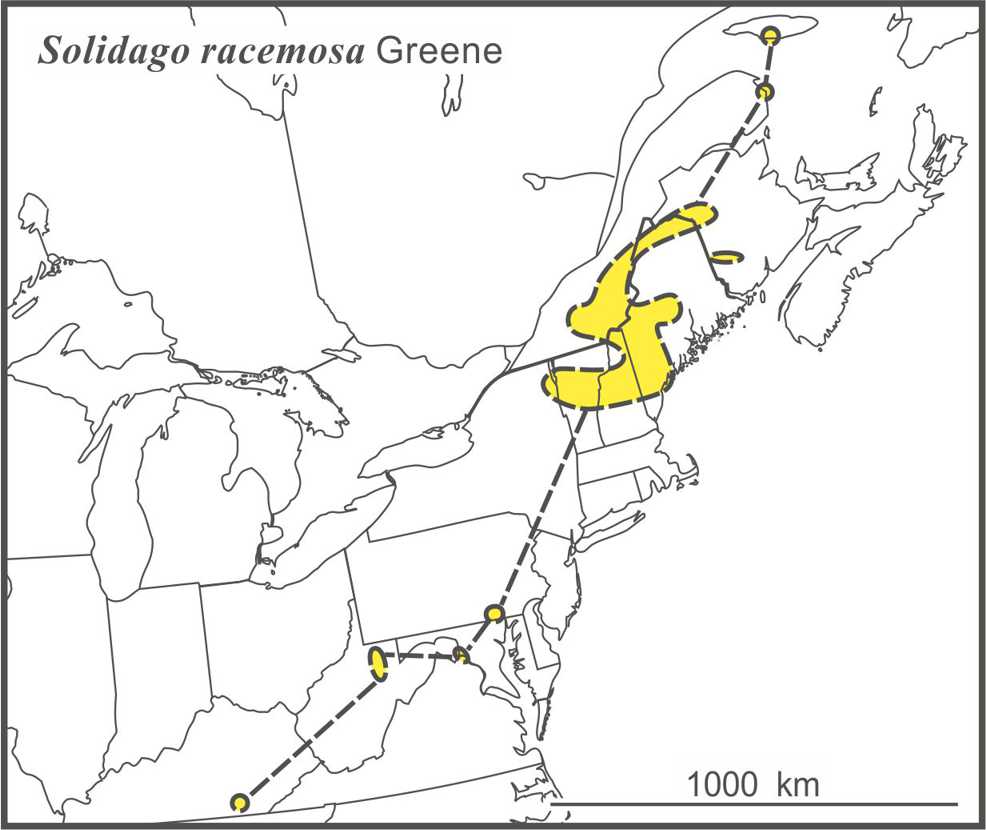Racemose Goldenrod
Solidago racemosa Greene is rare on calcareous rocks, ledges and cliffs along rivers at lower elevations in disjunct populations in Québec, New Brunswick, Maine, Vermont, New York, Pennsylvania, Maryland, West Virginia and Kentucky (Semple et al. 2019). The species was treated as Solidago simplex var. racemosa (Greene) Ringius by Semple & Cook (2006 FNA) and included in the eastern ssp. randii. Semple & Peirson (2013) supported recognition of the taxon at the species level. The species is tetraploid throughout its range and hexaploid at one location in West Virginia (Peirson et al. 2012).

Semple et al. (2019) presented a multivariate analysis of all 13 species of subsect. Humiles. Solidago racemosa was included in multiple analyses comparing it to all other species, to just the 6 species native to mid western and northeastern US and eastern Canada, to S. randiiand to S. arenicola. Specimens of S. racemosa separated well from those of S. randii and from those of S. arenicola, but less so in the analyses with all species, sometimes being placed a posteriori into S. ontarioensis. A collection included in the analyses as a member of S. racemosa (Morton NA4142 TRT from Percé Mt., Gaspésie, Québec) was reported to be diploid (Morton 1981) and was discussed by Ringius (1985) but not assigned to any variety within S. glutinosasensu lato. If the diploid count (Morton 1981) was made from the rootstock of the specimen on the voucher herbarium sheet, then it is the only diploid count for S. racemosa. In the S. randii/S. racemosa analysis the specimens were assigned a posteriori to S. racemosa with 77% probability. The single S. racemosa specimen from Kentucky (Peirson 612 MICH) included in the analyses was assigned a posteriori to S. racemosa with 100% probability in the S. arenicola/S. racemosa analysis.
Ringius, G.S. 1985. A biosystematic study of the Solidago spathulataDC. - S. glutinosa Nutt. complex (Compositae: Astereae). Ph.D. dissertation. University of Waterloo: Waterloo, Ontario.
Semple, J.C. , and J.A. Peirson. 2013. A revised nomenclature for the Solidago simplex complex (Asteraceae: Astereae). Phytoneuron 2013-41. 1-5.
Semple, J.C., K. Kornobis, A. Mazzorato, G.S. Ringius, and J.A. Peirson. 2019. A multivariate morphometric analysis of Solidago
subsect. Humiles (Asteraceae: Astereae). Phytoneuron 2019-25: 1–61.
Last revised 19 May 2025 by J.C. Semple
© 2025 J.C. Semple, including all photographs unless otherwise indicated
1-6. Solidago racemosa. 1. Plant on rocks, Semple & Brouillet 3407, Drummondville, Québec. 2. Ringius sampling along Susquahanna R., Pennsylviania. 3. Small plant,Semple & Ringius 7612, York Co., Pennsylvania. 4. Ringius and plant on rocks of Potomoc R., Maryland. 5. Heads, Peirson 601 MICH, Barbour Co., West Virginia. 6. Fruit, drawing by JCS.











